A historically young U.S. team came together to secure a return to the World Cup—and it plans ‘to f---ing do some damage’ while in Qatar.
When team security notified Gregg Berhalter that four of his younger players didn’t return to their hotel until 4 a.m., the relatively new coach had a decision to make: He could either display his power or he could choose to share it.
Berhalter had been on the job for about seven months when the 2019 Concacaf Gold Cup, his first meaningful competition as U.S. men’s national team manager, began. The youth movement the Americans are riding to this month’s World Cup had barely started. But Berhalter knew it was coming, and it informed his response that morning.
The Americans’ traumatic failure to qualify for the 2018 tournament had been like a forest fire that cleared away older, larger trees while making room for new growth. When he interviewed for the job, the former U.S. defender sat with federation executives and detailed what was taking root. “I showed them where the player pool could go based on these young talents that we have that are still in this formation phase: They’re not ready now, but they could be ready,” Berhalter says.
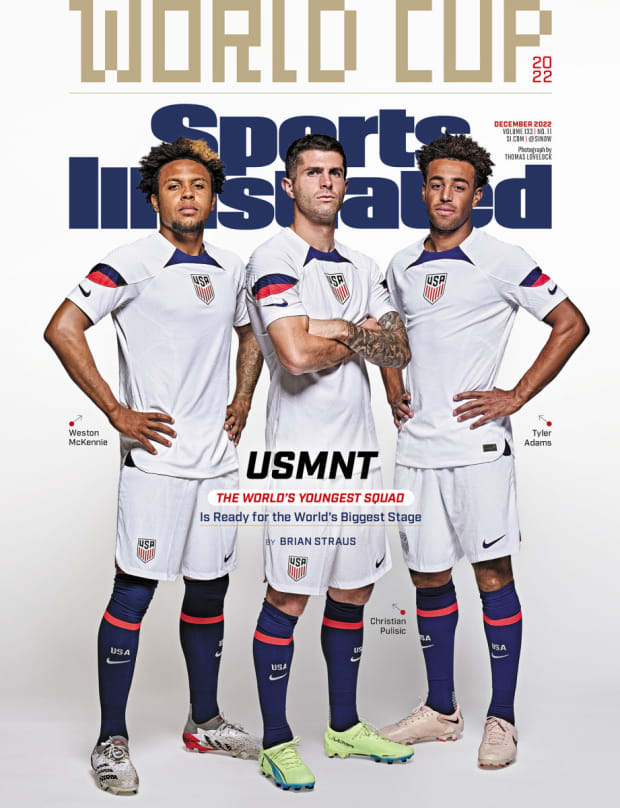
Thomas Lovelock/Sports Illustrated
Young men may not be ready for the rigors of a World Cup qualifying campaign, not to mention the unique stress of the tournament itself. They may think that straggling in shortly before sunrise, even with the next match three days away, is O.K. There’s a reason, after all, that the average player age of World Cup winners is just under 27. Berhalter and his staff knew they were laying a foundation designed to underpin something far larger than that Gold Cup. They planned to use youth as the foundation of a team that could compete in Qatar.
So, that morning, instead of discipline, there was dialogue.
“It was about, ‘O.K., guys, we need to align our expectations here. We’re in a freaking tournament. We’re trying to win. We’re not here to go out. ... But if you need to be with family, friends, whatever you want to do [after a game], you guys come to me with a curfew you think is reasonable,’ ” Berhalter remembers telling his players.
The next day, after a team meeting, they did—2:15 a.m.
“I was like, ‘2:15? Really? How did you guys come up with 2:15?’ ”
Well, they don’t get back from the stadium until around 11 p.m. Then there’s a team meal, and after you add a couple of hours to go out, you get 2:15. Obviously.
“I go, ‘Done. 2:15,’ ” Berhalter says, laughing. “It was funny to be negotiating with these guys.”
It was crucial, too. This is the generation that’s supposed to, as Berhalter says frequently, “change the way the world views American soccer.” The players had to feel empowered, and at the same time they had to see the coaches as colleagues on their journey.
“It’s a huge thing, that you feel that you can go and talk to [the coaches] and say, ‘Hey, I think we should do this.’ With younger kids, that’s really important,” says DeAndre Yedlin, the 29-year-old Inter Miami defender who’s one of only two players in the U.S. pool with World Cup experience. “They feel, This is also my team. I also have a say. I helped formulate this culture and this balance.”
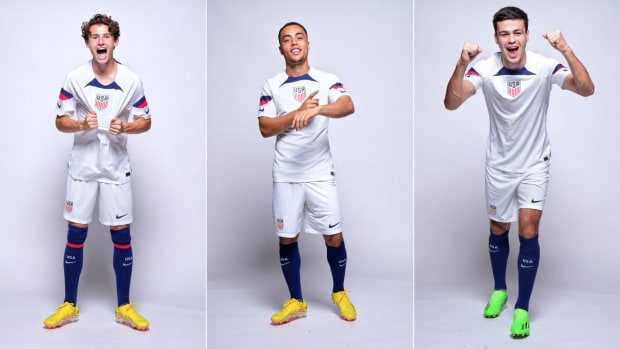
Thomas Lovelock/Sports Illustrated
There are countries that produce talent on a sustained, industrial scale. But nations below that tier experience ebbs and flows. Berhalter, U.S. men’s GM Brian McBride and U.S. Soccer sporting director Earnie Stewart, who all came aboard following the 2017 qualifying disaster, were part of a cohort that reached the World Cup quarterfinals in ’02. But that run, sparked by 20-year-old phenoms Landon Donovan and DaMarcus Beasley, was an anomaly.
The effort to establish a more reliable player development culture kicked off in the mid-2000s as U.S. Soccer introduced its academy platform (now operated by MLS), a scheme inspired by those offering the sort of professional coaching and training regimens found in more established soccer countries. MLS mandated free-to-play youth sides managed by professional coaches. Kids, as they are across the rest of the planet, would be taught to play rather than pressured to win. Four years ago commissioner Don Garber said MLS clubs were spending a total of around $100 million annually on youth development. This generation represents the return.
Among the 38 players Berhalter deployed during World Cup qualifying, 17 were forged at MLS academies, and six others spent at least a season with an MLS youth outfit. There are now MLS products at clubs in the English Premier League, Germany’s Bundesliga, Italy’s Serie A and France’s Ligue 1. “It’s definitely not an accident,” McBride says. “Certainly a large part of it is the standards that were put in place that the academies had to follow, and then coaching got better. It didn’t happen overnight.”
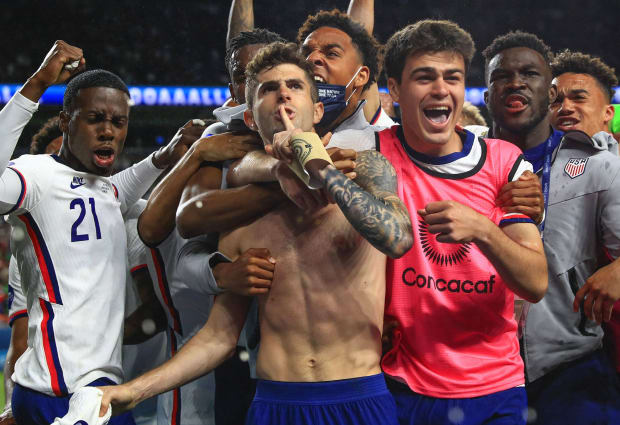
Adrian Macias/Imago
In the summer of 2021, shortly after Chelsea’s Christian Pulisic, then 22, became the first American man to play in and win the UEFA Champions League final, Berhalter split his player pool into an MLS-heavy roster and a predominantly Europe-based squad and claimed both the Concacaf Nations League and Gold Cup titles. By the time World Cup qualifying began in September, the coaching staff was asking U.S. Soccer staffers for data on how their team compared to the rest of the world. If the tentative and uneven 1-0-2 start didn’t reveal the squad’s relative inexperience, the numbers certainly did.
During that September 2021 stretch, Berhalter’s starting XIs averaged 23.91 years old—the youngest of the nearly 90 countries for which U.S. Soccer had data. Norway’s average, which was the second youngest, was more than a full year older. By the time qualifying concluded this March, the U.S., which finished 7-3-4, had fielded the eight youngest individual starting lineups among the 95 sides that advanced to the final round of their respective continental competition (except Oceania). The second-youngest team to book passage to Qatar, Ghana, started players who averaged nearly two years older (25.67 to 23.83).
Berhalter referenced his group’s youth with the press and public far more frequently than he did with his players, but as the Americans celebrated qualification in San José, Costa Rica, the manager told them, “We’ll be the youngest team in the World Cup in 2022, boys, the youngest team. And guess what? We’re going to f---ing do some damage.”
Outside the locker room at the Estadio Nacional, Pulisic said, “I just don’t think it’s about age. We have a hungry team—a hungry bunch of guys who are playing at top-level clubs across the world. And I think we can go in with confidence no matter what and no matter our age.”
That hunger, the sort that spurred Pulisic to leave central Pennsylvania for Borussia Dortmund at the age of 16, is fundamental to the culture and environment Berhalter started building with that Gold Cup negotiation.
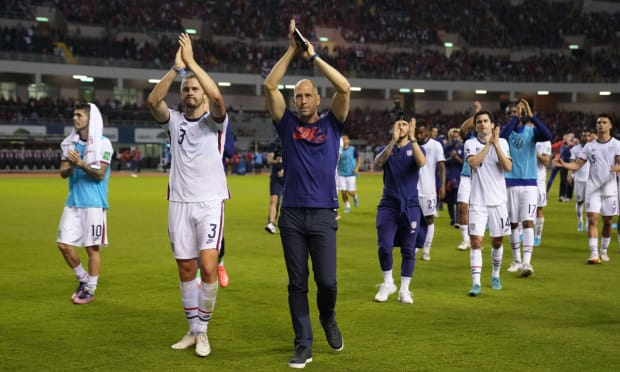
Brad Smith/ISI Photos/Getty Images
Jurgen Klinsmann, who coached the U.S. from 2011 until the wheels started falling off the ’18 qualifying campaign, believed in building teams through discomfort. A World Cup champion as a player for West Germany in 1990, he wanted his charges constantly on their toes and ready to respond to changing tactics, unpredictable or counterintuitive lineups, fluid schedules and the whims of their all-powerful manager. Berhalter and his staff, conversely, trust the players to provide the motivation. In exchange, they’ve worked on creating an environment that prioritizes chemistry, cohesion and compromise—one tailored expressly for a generation of players who prize individual expression and connection with others in equal measure. National team camp now is a place of kinship and support, as well as a stage for American soccer’s vanguard to realize its potential. Every element is accounted for, both on the field (Berhalter is somewhat notorious for his attention to positional and strategic detail) and off (even the games available in the players’ lounge, from Ping-Pong and board games to VR golf, were selected with their preferences and energy in mind).
The U.S. has no captain, although Berhalter plans to have the players select one for the duration of the World Cup. Instead, a “leadership council” of around a half dozen players (including Pulisic and midfielders Weston McKennie and Tyler Adams) has served as the de facto link between workers and management while providing on-the-job training for future potential captains. In November 2019, a few months after the Gold Cup, the council informed Berhalter that afternoon practices, which had been scheduled to accommodate jet lag, were actually harder on players accustomed to morning training. Times were adjusted immediately. Team leadership also helped organize and unite the group behind public statements and support for racial justice and gun reform—messages that indicated what sort of nation this generation wants to represent.
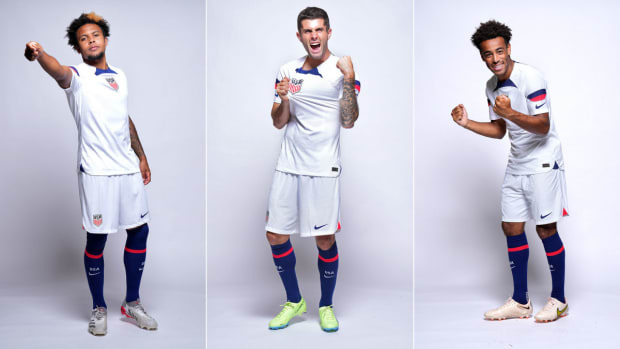
Thomas Lovelock/Sports Illustrated
In addition to the games and diversions—“It’s not like when you’re dealing with older players and they want to go to their room and nap,” says Berhalter—U.S. Soccer provides a team barista and barber, among other necessities or amusements. Energy abounds, and meetings have been shortened to adjust to the demographic decline in attention span. “Now it’s like 15 minutes where we start to red-flag it,” Berhalter says.
Coaches layer information through tailored video presentations and one-on-one conversations. Near-constant communication continues once camp is over, and the coaches keep track of which staffer should be reaching out to which player, whether to discuss their most recent club game or just check in.
Forward Tim Weah, 22, who won the 2020–21 Ligue 1 title with Lille, says the frequent contact was vital to enduring a long injury layoff during the previous season. Weah, who’s the son of former FIFA World Player of the Year and Liberian president George Weah, appreciates the emotional support as much as the chats with Berhalter about their shared shoe obsession.
“You can talk to them as peers. Obviously you have that respect because they’re your elders, but I can go to them and just start talking about music, talk about sneakers. And I think that’s what creates a bond and I think they’ve done such a great job just keeping that space open,” says Weah, who’s also the team DJ. “They’re older than us, but they still have that connection to our generation, and I think that’s super dope.”
Coaches take part. They’ll play Ping-Pong with players on an afternoon off, join them in conditioning exercises and even adopt the same dietary restrictions during camp. “That’s done with the idea that we still want to make progress on the field,” says Berhalter. “So it’s to get something else on the field. It’s not just O.K., we’re going to give you this free time and forget about soccer. Soccer is always the main thing, and team is always the main thing.
“We’re always fostering interactions. It’s always about the group. It’s always about how we make people welcome in the group, how the group is supporting each and every individual.”
That love—or “brotherhood,” as the players consistently call it—isn’t typical for national teams. They’re disconnected by definition, all-star squads that gather intermittently and then disperse for months. Players come and go, rise and fall. Internal fault lines, like those that emerged under Klinsmann, or simply a lack of familiarity and chemistry among men who spend so much time apart, can tank a talented squad.
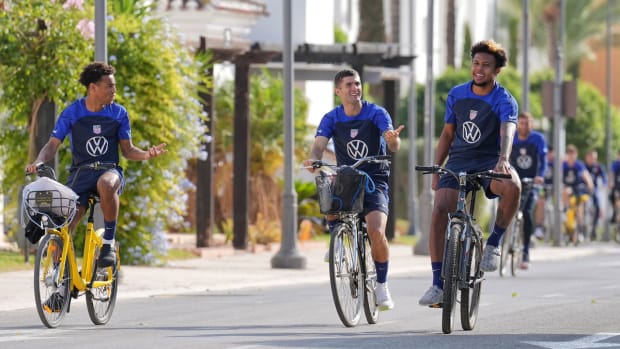
Thomas Lovelock/Sports Illustrated
“I play with guys that go to national teams. I know it’s not that way. A lot of the guys maybe aren’t as close or maybe they don’t want to be at camp. They want to go on summer vacation,” then 21-year-old forward Brenden Aaronson said in June, as the U.S. gathered for four games following the end of a long European club season. “But this is our time to play for the national team. We want to be with each other.”
Camp can be a refuge for young players trying to navigate the highest, most treacherous levels of the global game—a place where they know their role, know what’s expected and trust that their physical and mental well-being is valued. “I just love coming into the national team and sometimes, with long seasons and a lot of ups and downs, it can be very good to get away, and the national team is an amazing place for it,” Pulisic says.
The environment inside the U.S. squad also has acquired a reputation—and become a valuable recruitment tool. Dual nationals like Valencia midfielder Yunus Musah, a rising 19-year-old star born in New York City who could’ve chosen to play for England, Italy or Ghana; 22-year-old AC Milan defender Sergiño Dest, who was eligible to represent his native Netherlands; and 20-year-old Glasgow Rangers attacker Malik Tillman, who played for Germany’s youth teams, all committed their international futures to the U.S. For those who spent their upbringing further from American culture, the national team offers a chance to embrace those roots alongside others their age. Weah, who grew up in Brooklyn, spent the summer of 2021 showing Musah, who moved to Italy as a baby, around his hometown. This summer, Musah spent time in South Florida with McKennie, 24, and England-born defender Antonee Robinson, 25, among others. A group of U.S. players commandeered a van during the June camp in Cincinnati so they could introduce Tillman to Chick-fil-A.
Players on vacation will send texts of their adventures to their coach. “I get pictures of them on a boat or something,” says Berhalter. “Just dumb stuff, but it’s funny.”

Berhalter, 49, is the father of four children. The oldest, 21-year-old Sebastian, was a Columbus Crew academy player while Gregg coached the MLS side and now plays for the Vancouver Whitecaps. Connecting with young pros, matching their energy and understanding their needs and motivations is part of who the elder Berhalter is. For all the research, consultation, planning and “intention” that goes into training and preparing the national team, the indefatigable Berhalter also seems to be naturally suited for the job. “It’s just who I am,” he says.
“He probably doesn’t get enough credit for that: man-managing the individual, then you have to manage the whole team,” says McBride. “He’s very good at both.”
A test of that management dexterity—a disciplinary situation far more precarious than that relatively benign Gold Cup incident—arose during last September’s opening qualifying window. McKennie, the midfield dynamo who is in many ways the charismatic, boisterous face of this U.S. generation, violated the team’s COVID-19 bubble ahead of the showdown with Canada in Nashville. Berhalter had to thread the needle: establish a standard of conduct while maintaining the allegiance of both the group at large and one of its most important players.
Berhalter sent McKennie back to his club, Juventus. He missed the tie against Canada, then the resounding 4–1 victory in Honduras three days later. But in October, McKennie was welcomed back enthusiastically, and he started in wins over Jamaica and Costa Rica.
“Weston’s an unbelievable kid,” says Yedlin. “But there was also the kind of thing where, as players we’re looking like, Is this gonna slide? Would this slide with the 26th player on the roster? For us, it was honestly, especially in hindsight, very nice to see what [Berhalter] did.”
McKennie was humbled yet revitalized. Yedlin says he returned to the team with added maturity. “I remember the next camp we were riding on the way to training, and Weston was reading a book. I’ve never seen Weston read a book! He’s like, ‘Oh, yeah, I got into reading,’ ” Yedlin says.
Even when punished, McKennie never felt betrayed or abandoned by his coaches or teammates. The episode illustrated what’s different now, and potentially galvanizing, about this U.S. program. “I’ve had moments in my life where I’ve had to handle them whenever I’m in national team camp. I’ve had heartbreaks. I’ve literally cried in front of Gregg,” says McKennie. “I’ve had many situations where I can—any player can—really just go to someone on the coaching staff and sit down and have a life talk with them. That’s beneficial for us outside of soccer. We’re human beings.”
McKennie’s father, John, sent a tweet in November 2021 thanking Berhalter for “giving life lessons” to his son.
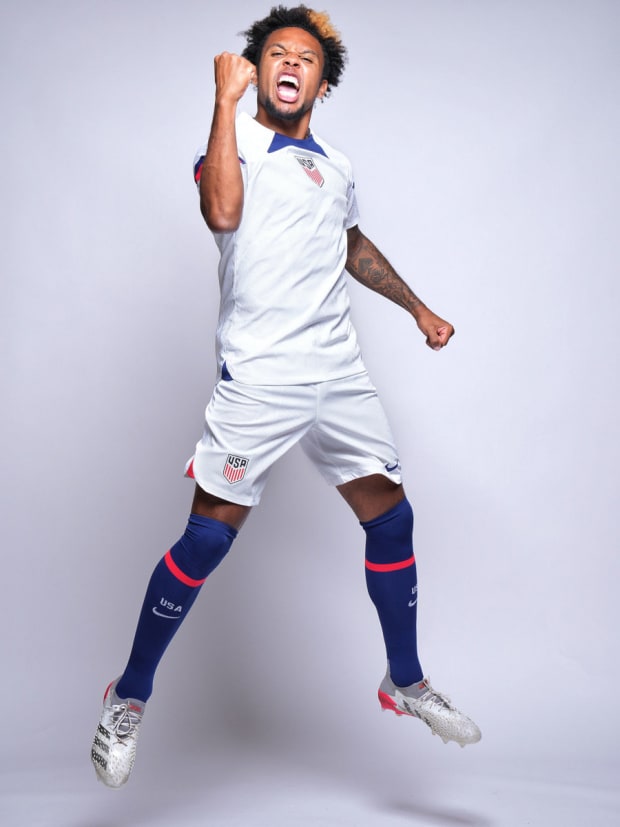
Thomas Lovelock/Sports Illustrated
The journey ends, for now, in Qatar, where the U.S. will face Wales, England and Iran in the stiffest test of Berhalter’s plan to turn the potential pitfalls of youth into an asset. England is a World Cup contender, while Wales and Iran were top-20 sides in FIFA’s October ranking. The 16th-ranked Americans are inexperienced. They’re also fit and relentless, playing a fast, vertical, high-pressing style that’s a tactical outgrowth of the squad’s youth and athleticism.
“[Berhalter] put in a plan in place that I don’t think any national team coach has been willing to take the risk of doing,” said Adams, the 23-year-old Leeds United midfield engine who’s become an influential U.S. leader and performer.
Adams said Berhalter “basically chang[ed] the whole way the system would work inside and out, whether it was our tactics, the players that we wanted to have, what certain positions needed to do ... basically how we can develop and get better.”
The youngest U.S. World Cup squad in the MLS era was Bob Bradley’s 2010 group winner, which averaged 27.28 years. To send a team averaging below 25 to a World Cup is almost unheard of. According to U.S. Soccer, Ghana’s entry in 2006 is the only one in the past four World Cups—that’s 128 different rosters—to come in below that benchmark. Thirteen of Berhalter’s 14 lineups during World Cup qualifying averaged under 25.
There’s still a sobering talent gap, at least statistically. According to Transfermarkt, the German website well known for its player valuations, the U.S. had four men worth at least $20 million as the summer transfer window closed: Pulisic, McKennie, Aaronson and Borussia Dortmund forward Gio Reyna. Reigning world champion France has 53—enough for two teams. England has 58.
But France, England and other big names have failed spectacularly on the World Cup stage because they can be shadows of the vast sum of their parts. Ego and club rivalries have torpedoed countless campaigns. The relatively harmonious French side that eased to victory four years ago in Russia was a notable exception for a talent-rich country that’s had famous difficulty establishing locker room harmony. Les Bleus coach Didier Deschamps declared following the 2018 final that the trophy was won when he named his roster: “You need to choose the men,” he said.
“It’s character over talent,” Berhalter says. “We’re not going to have the most talent in the World Cup. So we have to gain an advantage in other areas, and our advantage is our brotherhood.”
Never before has the U.S. featured players who were so accomplished, and so ambitious, so young. That’s just one of many things this unique squad, this golden generation, has in common.
“We’re not scared of anyone. We just love to compete,” Weah says. “That’s the mentality that this new generation has. We picked it up from the old heads. We love to compete, but we do it with such swagger. And it’s just amazing to see.”
• Gonzalez: Christian Pulisic vs. the Haters
• Straus: By George, Tim Weah Is Humbly Reaching His Potential
• Falkenheim and Prewitt: When Phony Environmentalism Comes to Sports